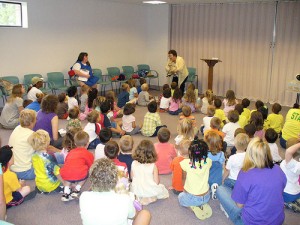Student guest post by Nikita Griffioen
It is a truth universally acknowledged that, when working with children, there is nothing a caretaker is more in want of than some peace and quiet.
Don’t get me wrong—working with children is a joy. This summer I had the privilege to oversee a class of seventeen kindergartners at a literacy day camp for a local Christian school. Their energy, curiosity, and genuine love of life is a delight to be around. Energy, curiosity, and genuine love of life, however, are paired with disruption, yelling, and endless reprimands to “Be quiet please,” “Tone it down,” and “Stop coloring on your face!”
It’s safe to say that any teacher becomes desperate for some order and quiet at around the midpoint of a day filled with yelling and overly dramatic play. Tactical methods are brought out to attain such order and quiet . . .
Story time.
 Photo Credit: Asheboro Public Library via Compfight cc
Photo Credit: Asheboro Public Library via Compfight cc
Quietly, with three carefully chosen books in my hand, I approach the chair and sit. A sea of expectant faces lies before me, having just sat down and still freshly squirming. Eyes are wide open, mouths are closed shut. The room is eerily still. For the first time all day, I can hear my own breathing.
The magic of story begins.
The stillness is broken slightly only by the rustling of pages as I open the first book. The room is perfectly motionless. The book is held up, so they see the illustrations. Only they do not just see it, they drink it in with their eyes, appreciating the line and playful color and how it illuminates the story as I read. My voice is the only one in the room, inviting them to use their imaginations again, silently and inwardly, as I tell them what happens if a mouse asks for a cookie. The occasional laugh begotten by a phrase or picture in the story is silenced by their neighbor saying, “Shh!” which I interpret as “Be quiet please, we want her to keep reading.” The magic is working.
When the first book ends, the silence remains, and I begin the second. Again, the little noise makers sit still to listen and watch. This is what to do if your kite gets stuck in a tree, I let them know. You may have to throw a whale up there to get it. Perhaps even a ship. Though an implausible situation, they take the information to heart. Some of them may wonder where to get a whale; most are simply glad that the beautiful kite can be restored back to earth. Imaginations run rampant—quietly.
After the second book, there is a murmur from the crowd. “Shh!”s are employed once more, and the squirming (mostly) ceases. I sense signs the first signals of botheration.
Book three—the final one—is opened. I know this is my last few minutes of peace, so I take my time. I add my own commentary into the story. They love it; they are attentive. “Look at the illustrations,” I tell them, pointing out a pink diamond beneath the earth. “Are Sam and Dave close to their treasure? What’s going on here?” They whisper among themselves, careful to keep as quiet as possible, lest I stop reading right then and there and forever keep the ending from them.
Finally the last page comes.
They are waiting for their signal.
I take a breath.
“The end,” I say.
All hell breaks loose. My moment of utter bliss has ended and dissolved back into a cacophonous reality as they run back to their toys, coloring, and noise making.
I sit back in the chair as madness ensues around me, and wonder at the magic of books. The three books clutched in my hands were more than just words and sweet pictures on paper; they were vessels of magic capable of enchanting seventeen youngsters into silence for an extended period of time. Do all adults know of the power of children’s literature? Is every adult using this strange hypnotism to its fullest potential? A magic such as this should be daily magic.
My thoughts are broken as a toy fire truck is thrown clear across the room. As I slide the books onto the chair in order to rush over to the commotion, I find myself wondering if we can have story time twice in one day.

Comments are closed.